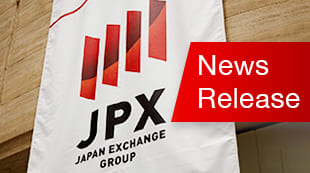Search results 9101-9110 / 10648
- sort:
- relevance
- latest

1 Revisions to the Handling of Unreceived Dividends, etc. Pertaining to Deposited Securities, etc. May 21, 2025 Tokyo Stock Exchange, Inc. I. Purpose Tokyo Stock Exchange, Inc. (TSE) will make needed revisions to its Brokerage Agreement Standards in light of a planned amendment by Japan Securities Depository Center, Inc. (JASDEC) to establish a limitation of actions for unreceived dividends, etc. (i.e., dividends, etc. that have not been received by their beneficial shareholders) under its Book-Entry Transfer System for Foreign Stocks, etc. (hereinafter referred to as the "Foreign Stock System"). JASDEC’s amendment aims to ensure stable system operation by eliminating handling specific to the Foreign Stock System and reducing the administrative burden on account management institutions. II. Outline Item Description Notes Revisions to Handling of Unreceived Dividends, etc. Pertaining to Deposited Securities, etc. A limitation of actions will be established that exempts the settlement company (JASDEC) and trading ...

1 Summary of Public Comments on "Optimization of Tick Sizes for Medium Liquidity Stocks" and TSE Responses March 8, 2023 Tokyo Stock Exchange, Inc. Tokyo Stock Exchange, Inc. (TSE) released the outline of "Optimization of Tick Sizes for Medium Liquidity Stocks" on December 22, 2022 and sought public comments until January 21, 2023. TSE appreciates the cooperation of those who gave their comments in reviewing this matter. The following is a summary of the comments received and responses from TSE. No. Summary of comment TSE response 1 ・XTX Markets (“XTX”) believes that appropriate tick size increments are important in all electronic markets globally. This allows liquidity to cluster at a price point and ensure market makers are taking meaningful risk when improving an existing price. ・A tick size that is too small results in a lack of depth, flickering in the order book and fragmentation of ...

1 Optimization of Tick Sizes for Medium Liquidity Stocks December 22, 2022 Tokyo Stock Exchange, Inc. I. Purpose For the purpose of improving the convenience of investment by lowering execution costs for investors when trading, Tokyo Stock Exchange, Inc. (TSE) optimized tick sizes in its regular trading session for high liquidity stocks from January 2014 to September 2015, and for ETFs, etc. (meaning ETFs and ETNs (including those aimed at tracking leverage indicators, etc.); the same shall apply hereinafter) in November 2021. However, for medium liquidity stocks, execution costs associated with tick sizes remain high from a global perspective, and we have received requests for revisions from market users. In light of this, TSE will optimize tick sizes for medium liquidity stocks with a view to developing an environment where various investors, centered around retail and long-term investors, can execute trades at better prices. Specifically, tick sizes applied to ...

Appendix Calculation of FFW for TSE REIT-related Indices (1) Outline - Free-Float Weight (FFW) is the percentage of listed shares deemed to be available for trading in the market. TSE calculates the FFW for shares of each REIT and uses this value in index calculation. The FFW for shares of REIT X may be different from that for REIT Y. - Steps for determining FFW (a) First, estimate the number of non-free-float shares (listed shares deemed to not be available for trading in the market) based on information gathered from securities reports and other documents required under the Financial Instruments and Exchange Act (hereinafter "the Act"), as well as from publicly available documents released by each REIT. (b) Second, calculate the non-free-float (non-FFW) ratio, which is the number of non-free-float shares divided by the total number of listed shares. (c) Third, obtain FFW ...

Revisions to Calculation Methodology for TSE REIT-related Indices October. 19, 2016 Tokyo Stock Exchange, Inc. I. Purpose Tokyo Stock Exchange has calculated and published Tokyo Stock Exchange REIT Index and Tokyo Stock Exchange REIT Property Sector Index Series (hereinafter, collectively referred to as "TSE REIT-related Indices"), which serve as indicators of the J-REIT market. Currently, TSE REIT-related Indices are calculated based on Full-market Capitalization weighting. However, with the aim of making the indices more suitable as underlying indicators for financial products, the calculation methodology will be changed to Free-float Adjusted Market Capitalizationweighting. II. Outline Item Description Remarks 1. Calculating FFW - The free-float weight (FFW) is calculated by first estimating the number of non-free-float shares, and then subtracting the non-free-float-share ratio from 1 (1 –non-free-float ratio). The number of non-free-float shares can be estimated by ...

(Provisional Reference Translation) Summary of Comments Submitted in the Public Consultation Procedure Regarding "Revisions to Calculation Methodology for TSE REIT-related Indices" November 22, 2016 Tokyo Stock Exchange, Inc. Tokyo Stock Exchange, Inc. ("TSE") released an outline of the "Revisions to Calculation Methodology for TSE REIT-related Indices" on October 19, 2016 and sought public comments until November 18, 2016. A summary of the comments and TSE’s responses are as follows. No. Summary of Comments TSE Response 1 Under estimation of non-free-float shares, "cases that TSE may treat as free-float" 1)Confirm the treatment of "XX Trust Bank (securities investment trust account)" 2)Clarify the types of cases with respect to“Global custodians”, and“Other entities who hold shares TSE deems as available for trading in the market”. 1) Please see the Index Guidebook. 2) TSE confirms the purpose of the shareholding based on financials ...

Outline of Introduction of Free-Float Adjustment for TSE REIT-related Indices November 22, 2016 Tokyo Stock Exchange, Inc. I. Outline Tokyo Stock Exchange, Inc. (TSE) announced today that it will introduce free-float adjusted weightings (FFW) for Tokyo Stock Exchange REIT Index and Tokyo Stock Exchange REIT Property Sector Index Series (hereinafter collectively referred to as "TSE REIT-related Indices") on January 31, 2017. Ⅱ. Schedule Monthly adjustments for phases one through four will take place after the close of trading on the business day preceding the last business day of Jan.–Apr. 2017, and the introduction of FFW will be completed after the close of trading on the business day preceding the last business day of May 2017. Start of Phase 1 (start transition) Jan. 31, 2017 (Tue.) (close of trading on Jan. 30, 2017 (Mon.)) Start of Phase 2 Feb. 28, 2017 (Tue.) (close of trading on Feb....

1 ©2016 Tokyo Stock Exchange, Inc. TSE Index Guidebook (Tokyo Stock Exchange REIT Index, Tokyo Stock Exchange REIT Property Sector Index Series) January 31, 2017 Tokyo Stock Exchange, Inc. Published: November 22, 2016 (Reference Translation) 2 ©2016 Tokyo Stock Exchange, Inc. 目次 Introduction............................................................................................................................3 Ⅰ. Outline of Indices.........................................................................................................3 Ⅱ. Index Calculation.........................................................................................................4 1. Outline........................................................................................................................4 2. Formula ......................................................................................................................4 3. Stock Price Used for Calculation..............................................................................4 4. Number of Shares Used for Index Calculation........................................................4 5. Free Float Weight Calculation..................................................................................5 6. Constituent selection for Tokyo Stock Exchange REIT Property Sector Index Series...................................................................................................................................7 Ⅲ. Adjustments to Base Market Value............................................................................7 1. Events that Require Adjustment..............................................................................8 2. Adjustment Method................................................................................................ 10 Ⅳ.Other ............................................................................................................................... 14 1. Publication/Dissemination of Index Data............................................................... 14 2. Licensing.................................................................................................................. 14 3. Exemption of liability ............................................................................................. 14 4. Contacts................................................................................................................... 14 3 ©2016 Tokyo Stock Exchange, Inc. Introduction ・Tokyo Stock Exchange, Inc. (TSE) calculates and publishes the Tokyo Stock Exchange REIT Index ...

Your Exchange of Choice ©2018 Japan Exchange Group, Inc. Index Data Correction Process Information Services Tokyo Stock Exchange, Inc. 1 (Reference Translation) ©2019 Japan Exchange Group, Inc. Correction Process 2 As a general rule, there will be at least 5 business days between the correction notification day and the correction day. Item subject to correction Correction day (1) Corporate action Where there are at least 5 business days between the correction notification day and the last business day of the current month: Last business day of the current month Where there are less than 5 business days between the correction notification day and the last business day of the current month: Last business day of the following month Where early correction is desirable in such cases as a stock split and reverse stock split, data will be corrected as promptly as possible. (2) Index constituent selection Day on which ...

(Provisional Reference Translation) Summary of Comments Submitted in the Public Consultation Procedure on "Formulating TSE Index Data Correction Policy" May 30, 2019 Tokyo Stock Exchange, Inc. Tokyo Stock Exchange, Inc. ("TSE") released a proposal for "Formulating TSE Index Data Correction Policy" on April 5, 2019, and held a public consultation until May 17, 2019. A summary of the comments received and TSE’s responses are as follows. No. Summary of Comments TSE Response 1 If TSE calculates and publishes an index in a manner inconsistent with the rules specified by the methodology, whether or not you carry out a retrospective correction of index values, we hope that you would ensure the transparency of the index by publishing details of the correction, such as the timing, contributing factors, and effects. As a general rule, if TSE identifies and corrects an error after calculating and publishing an index in a manner ...














